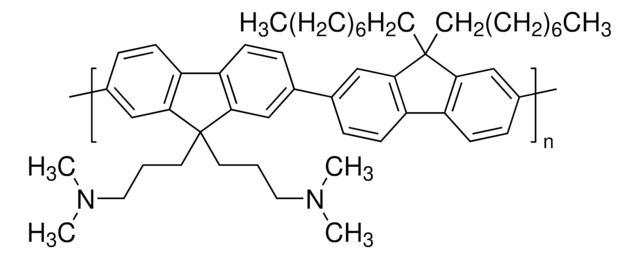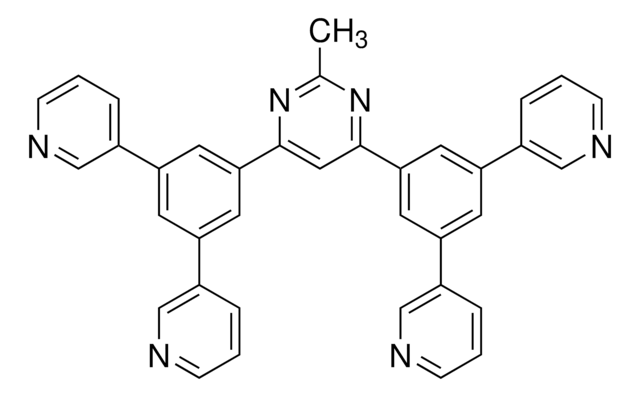Products may be shipped at a different temperature than the recommended long-term storage temperature. If the product quality is sensitive to short-term exposure to conditions other than the recommended long-term storage, it will be shipped on wet or dry-ice. If the product quality is NOT affected by short-term exposure to conditions other than the recommended long-term storage, it will be shipped at ambient temperature. As shipping routes are configured for minimum transit times, shipping at ambient temperature helps control shipping costs for our customers. For more information, please refer to the Storage and Transport Conditions document: https://www.sigmaaldrich.com/deepweb/assets/sigmaaldrich/marketing/global/documents/316/622/storage-transport-conditions-mk.pdf
907065
Poly-TPD
Mw ≥20,000 g/mol
Sinonimo/i:
4-Butyl-N,N-diphenylaniline homopolymer, Poly(4-butyl-N,N-diphenylaniline), Poly(4-butyltriphenylamine), Poly[N,N′-bis(4-butylphenyl) -N,N′-bis(phenyl)-benzidine]
Scegli un formato
About This Item
Prodotti consigliati
Descrizione
Solution processable
Stato
powder
PM
Mw ≥20,000 g/mol
Caratteristiche più verdi
Design for Energy Efficiency
Learn more about the Principles of Green Chemistry.
sustainability
Greener Alternative Product
Punto di fusione
>300 °C
Energia dell’orbitale
HOMO -5.2 eV
LUMO -2.4 eV
Categoria alternativa più verde
Temperatura di conservazione
15-25°C
Descrizione generale
Applicazioni
Indoor photovoltaics is one of the best sustainable and reliable energy source for low power consumption electronics such as the rapidly growing Internet of Things.
In another recent study, Perovskite photovoltaic (PPV) cells with a mesoporous PPV (mPPV) structure using typical Spiro-OMeTAD as the hole transport layer (HTL) shows the highest maximum power density (Pmax) of 19.9 μW/cm2 under 200 lux and 115.6 μWcm-2 under 1000 lux (without masking), which is among the best of the indoor PV. When PEDOT:PSS is replaced by Poly-TPD as HTL in the inverted PPV (iPPV) cell, the Pmax under indoor light improves significantly and is comparable to that of the best mesoporous mPPV cell.[2]
Device performance:
iPPV-Poly-TPD
1. under one sun [Pin=100 mW/cm2]
Jsc=21.8 mA/cm2
Voc=1.07 V
FF=73.7%
PCE=17.2%
2. under 1000 lux [200 lux]
Jsc=172.3 mA/cm2
Voc=0.851 V
FF=75.9%
Pmax=111.3 mW/cm
- Organic Light Emitting Diode (OLED): Hole transport layer / Electron blocking layer (HTL/EBL) Materials
- Solution-Processed OLED : Polymer hole transport layer
- Dye-Sensitized Solar Cell (DSSC):Hole transport materials
- Perovskite Solar Cells:Hole transport material
- Flexible Printed Electronics:Hole transport layer / Hole injection layer(HTL/HIL) Polymers
Codice della classe di stoccaggio
11 - Combustible Solids
Classe di pericolosità dell'acqua (WGK)
WGK 3
Punto d’infiammabilità (°F)
Not applicable
Punto d’infiammabilità (°C)
Not applicable
Scegli una delle versioni più recenti:
Possiedi già questo prodotto?
I documenti relativi ai prodotti acquistati recentemente sono disponibili nell’Archivio dei documenti.
I clienti hanno visto anche
Articoli
Professor Chen (Nankai University, China) and his team explain the strategies behind their recent record-breaking organic solar cells, reaching a power conversion efficiency of 17.3%.
-
How is shipping temperature determined? And how is it related to the product storage temperature?
1 answer-
Helpful?
-
-
How can I determine the shelf life / expiration / retest date of this product?
1 answer-
If this product has an expiration or retest date, it will be shown on the Certificate of Analysis (COA, CofA). If there is no retest or expiration date listed on the product's COA, we do not have suitable stability data to determine a shelf life. For these products, the only date on the COA will be the release date; a retest, expiration, or use-by-date will not be displayed.
For all products, we recommend handling per defined conditions as printed in our product literature and website product descriptions. We recommend that products should be routinely inspected by customers to ensure they perform as expected.
For products without retest or expiration dates, our standard warranty of 1 year from the date of shipment is applicable.
For more information, please refer to the Product Dating Information document: https://www.sigmaaldrich.com/deepweb/assets/sigmaaldrich/marketing/global/documents/449/386/product-dating-information-mk.pdfHelpful?
-
-
해당 물질의 용액 제작에 어떤 solvent 사용하는지 알고 싶습니다.
1 answer-
This product has not been tested for solubility. However, various sources state that this chemical can be solubilized in chloroform or chlorobenzene. The concentrations at which it can be solubilized are not determined.
Helpful?
-
Active Filters
Il team dei nostri ricercatori vanta grande esperienza in tutte le aree della ricerca quali Life Science, scienza dei materiali, sintesi chimica, cromatografia, discipline analitiche, ecc..
Contatta l'Assistenza Tecnica.










